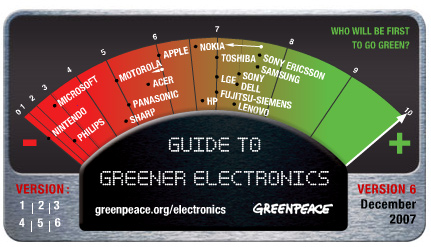Video game-makers score low on sustainability
Video game-makers score low on sustainability
mongabay.com
November 27, 2007
Video game console manufacturers are doing a poor job eliminating toxic chemicals from their products, according to environmental group Greenpeace.
In the sixth edition of its ‘Guide to Greener Electronics‘, Greenpeace says that “Microsoft, Nintendo, Philips and Sharp enter at the bottom of the ranking of environmental performance.” Nintendo became the first company to score zero out of a possible ten points.
Sony Ericsson tops the list, followed closely by Samsung. Both companies have made progress towards eliminating hazardous ingredients from their products and offer take-back and recycling programs.
 The Landsat Image Mosaic of Antarctica (LIMA). Courtesy of NASA/USGS |
The global computer games sector shipped 62.7 million units in 2006, up 14.9 percent from 2005.
“The low scores from leading manufacturers Nintendo and Microsoft reveal that they have a long way to go to improve their environmental policies and practices,” said Greenpeace in a statement.
“To achieve higher rankings, companies really need to walk the talk instead of making vague commitments to future progress,” said Rick Hind, Legislative Director of the Greenpeace toxics campaign in the U.S. “Environmental leadership and innovation are evident as companies put products on the market free of hazardous chemicals and institute recycling take-back programs which are actually operational.”
Greenpeace Ratings
BEST
| 7.7 | Sony Ericsson – New leader due to improved takeback reporting, new models PVC free, but falls down on takeback practice. | |
| 7.7 | Samsung – Big improvements, with products free of the worst toxic chemicals. Loses points for incomplete takeback practice. | |
| 7.3 | Sony – products free of toxic PVC and improved reporting on recycling and takeback especially in the US. | |
| 7.3 | Dell – Unchanged since the last version, still no products on the market without the worst chemicals. | |
| 7.3 | Lenovo – Unchanged since the last version, still no products on the market without the worst chemicals. | |
| 7 | Toshiba – Much improved on toxic chemicals but still lobbies in the US for regressive takeback policies. | |
| 7 | LGE – Unchanged since the last version, need better takeback for products other than phones. | |
| 7 | Fujitsu-Siemens – Unchanged since the last version, needs toxic elimination timelines, better takeback coverage and reporting of amounts recycled. | |
| 6.7 | Nokia- A steep fall! Strong on toxic chemicals but penalty point deducted for deficiencies in takeback practice in Thailand, Russia and Argentina during our testing. | |
| 6.7 | HP – Finally provided timelines for eliminating worst toxic chemicals, though not for all products; needs to improve takeback coverage. | |
| 6 | Apple – Slightly improved with new iMacs and some iPods reducing the use of toxic chemicals, takeback program still needs work. | |
| 5.7 | Acer – Unchanged since the last version, needs better takeback coverage and reporting of amounts recycled. | |
| 5 | Panasonic – Unchanged since the last version, need better takeback coverage and reporting of amounts recycled. | |
| 5 | Motorola – Big faller due to penalty point for poor takeback practice in Philippines, Thailand and India revealed by our testing. Still no timelines for eliminating the most harmful chemicals. | |
| 4.7 | Sharp – New to the guide – some plus points on toxic chemicals elimination but poor takeback policy and practice. | |
| 2.7 | Microsoft – New to the guide – long timeline for toxic chemicals elimination (2011) and poor takeback policy and practice. | |
| 2 | Philips – New to the guide – no timeline for toxic chemicals elimination and zero points on e-waste policy and practice. | |
| 0 | Nintendo – New to the guide – first global brand to score zero across all criteria! |